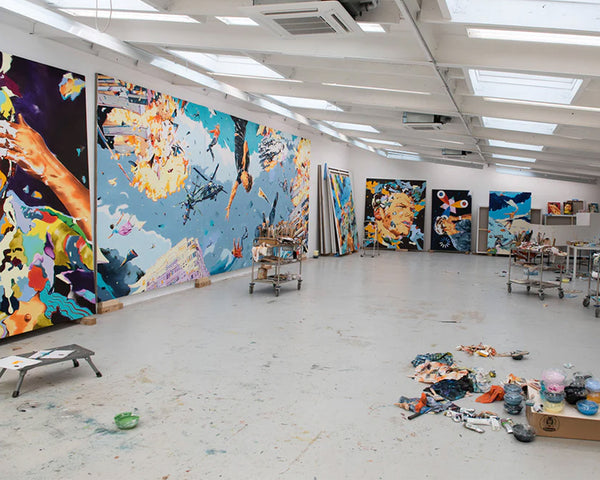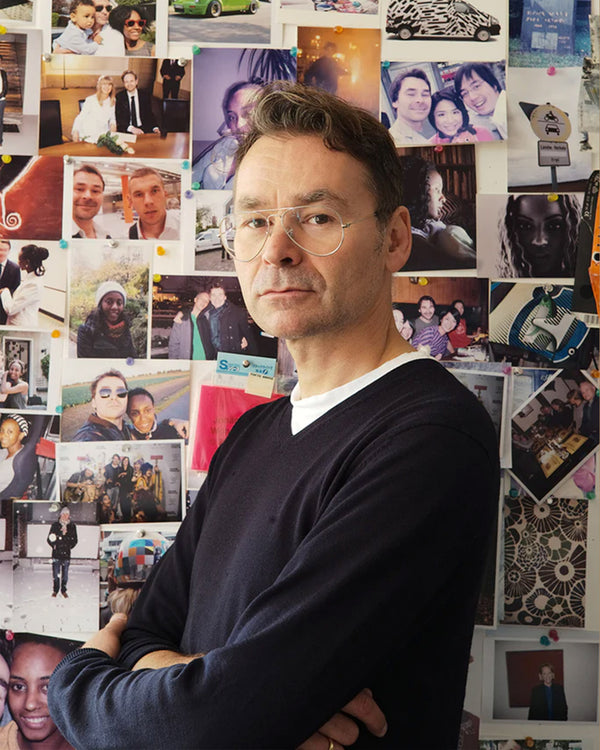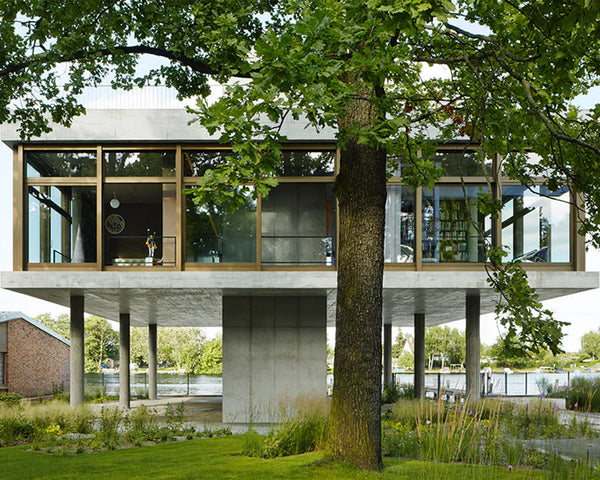XIYAO
WANG
Painting
Large
Format
For
Me
Is
Like
Swimming
in
the
Sea
6 April 2023
»I'll keep waiting until the painting tells me, now it’s finished.«
»I'll keep waiting
until the painting tells me,
now it’s finished.«

Studio of Xiyao Wang in Moabit, Berlin
Ahead of her first exhibition at König Galerie, ON THE WAY TO PENGLAI ISLAND, Xiyao Wang invited us into her studio in Berlin to take stock of her progress before installation. The Chinese-born painter also sat down for an interview to give us greater insight into the process of creating her massive, energetic, and striking tableaux. What follows is a short excerpt from this conversation with photos taken on that wintery day in Berlin, where the light from outside collaborated with the unique illumination that the artist works so hard to achieve with her art.
Portrait of Xiyao Wang
König Galerie: How did you come up with the title for the exhibition, and what does it mean to you?
Xiyao Wang: The title of the exhibition is ON THE WAY TO PENGLAI ISLAND, and I came up with this title because while I was preparing for the show, I was reminded again of the metaphor about Penglai Island. I find the story extremely touching and exhilarating and fits to my current living conditions and way of working. I also like the state of “on the way”, I really enjoy the process itself: the process of searching, the process developing, the process growing. I am always on the way, on the way of self-improvement in all aspects.

Xiyao Wang preparing her show ON THE WAY TO PENGLAI ISLAND at König Galerie
KG: Can you describe your working process, how you start painting, and, in particular, the choice of the background?
XW: For this new grouping of paintings, I start directly with charcoal on the white canvas. And then I use finger and oil stick. Instead of doing sketch for the painting, I always take enough time to look at the empty canvas. I have to think very clearly from the outset and make certain decisions: Where do I begin? Where do I end up? Where do I turn this material, the charcoal, so that they have different layers? Of course, you cannot perfectly plan everything ahead of time, which is why you need a greater skillset and a lot of experience – to be able to observe yourself during the process of painting and keep what you’re doing in check.
KG: How do you decide when a painting is finished? Which criteria determine when a work is completed?
XW: To make the decision for when the painting is finished is always very difficult. But after so many years working experience, I can do it better and better, and I find out that waiting is the most important thing for me to make the right decision for the painting. Now, when I am not sure, if the painting is finished or not, I will look at the painting and analyze all the details again and again, and I just wait. I'll keep waiting until the painting tells me, now it’s finished or it’s still not finished. It’s hard to say which criteria determine when a work is completed, because it’s really depend on. It’s not always the same. Each painting has its own individual and independent life and character.
KG: What drew you to painting your large format works?
XW: Larger formats have much more free space than smaller ones. For me, painting large-format works is like swimming in the sea instead of in a swimming pool.
KG: How is this new grouping of paintings different from what you've made before?
XW: The new paintings are more minimalistic. I try to edit out the elements that I no longer identify with. They all have very clean, white backgrounds as opposed to the colored background that I had used in previous works. Now, I am using a different technique. I am no longer using a brush. I use charcoal, oil stick, and my fingers in these newer paintings. There is a stronger contrast between marks and background now. KG: Do you conceive of a series or paintings beforehand, or do they develop organically into an exhibition? Does this affect the way you paint each picture?
KG: Do you conceive of a series or paintings beforehand, or do they develop organically into an exhibition? Does this affect the way you paint each picture?
XW: I would say it happens in both ways. I conceptualize first, but I also let that develop to a certain extent organically. I always begin to prepare the exhibition very early and I plan especially for the exhibition space, its scale, color, and style. After that is set, during the preparation process, then the paintings begin developing organically by themselves.
KG: The white background is more prominent in these large paintings? How did that develop, and what challenges did it pose to the way you painted them?
XW: That's correct. Having this white background is very challenging. It requires a lot of courage and experience since there is no mistakes that could be hidden or covered up. Self-challenge and improvement are always motivations for my work.

KG: The question of light – from outside, and also within each painting – seems paramount for what you are doing. Is light an essential quality in your work?
XW: When you go to a museum, you will find out that the light in an exhibition room for traditional oil paintings is much darker than the light for contemporary paintings, because the older works have light painted into them. People can see the light in my paintings, since I also like the element of light, and try put it into my paintings. How does it get there? It seems to always come naturally, somehow. I don't even have to do it intentionally like the other elements I am interested in adding in any given painting. So, to clarify, although it comes automatically, light is not necessarily essential to the work that I do.
KG: How does perspective function in your paintings? Is there an ideal position for you as painter, or one for a viewer?
XW: Since my paintings are always about weightlessness and flying, there is always perspective like when you are flying over clouds, mountains, rivers, and seas. Also, from the perspective of flying through a landscape. For the viewer, my paintings are always like an open story. Each viewer can have their own special perspective. They can connect with themselves and their own story through the painting.






